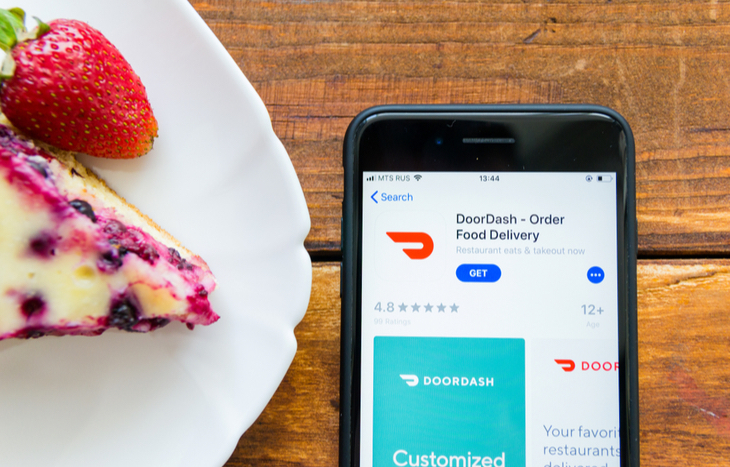3 Big Risk Factors: DASH Stock Forecast
DoorDash Inc (NYSE: DASH) and other food delivery apps surged in popularity during the pandemic. With social distancing rules in place, there were few options other than to use a delivery app. However, social distancing is no longer enforced in most of the country. For this reason, DoorDash’s booming business has slowed to more moderate growth. DASH stock is also now down 50% so far in 2022. But, the worst is probably still ahead. Let’s examine three big reasons why this once-hot stock could continue to fall.

DASH Stock Forecast
DoorDash Inc is one of the largest food delivery services in the United States. According to Bloomberg Second Measure, it controls 59% of the delivery market. Uber Eats (24%) and Grubhub (13%) are the next biggest players.
DoorDash got started exclusively in food delivery. However, it has expanded its service to include general convenience items. It was founded in 2013 and went public in 2020. DoorDash currently operates in the United States, Canada, Australia, Japan and Germany.
Recent Announcements:
- Acquired Wolt in an all-stock transaction. Wolt is a European-based food delivery company based in Finland.
- Acquired technology startup Bbot.
- A glitch in DoorDash’s system allowed users to get free food.
As far as its financials, DoorDash is still unprofitable. However, its revenues have been increasing consistently. In Q1 2022, DoorDash reported revenue of $1.46 billion, up 35% YoY. It also reported a net loss of $167 million. If you look at the past few years, DoorDash’s revenue growth becomes more pronounced. DoorDash’s revenue has grown from $885 million in 2019 to $4.89 billion in 2021. This represents a growth of 147.5% annually.
Additionally, DoorDash recently posted a quarterly record for monthly active users and Door Pass users. DASH stock is down 58% since the company went public.
Is DASH Stock a Buy? Potential Upsides
DoorDash has done a good job of pioneering this new industry. On a path similar to Uber, DoorDash has had to pave its own way and make up rules as it goes. This is a testament to the resiliency of the company’s leadership team. DoorDash is still run by one of its co-founders, Tony Xu.
One example of smart leadership is in DoorDash’s strategy for innovation.
DoorDash uses a bottom-up strategy to uncover new product ideas. This means that it pools ideas from its customers, Dashers and restaurant partners. This is incredibly smart. As the main users of the app, these parties will know best how it could be improved. It’s also a good sign that top management doesn’t have an ego and won’t try to force unwanted product enhancements on users. Once DoorDash sources an idea, it assigns a small team to create and implement it. The company then expands on projects that are well received. And, it cuts any projects that don’t receive good feedback.
A few examples of innovations that are a result of this strategy are:
- Convenience delivery
- Entering new countries
- The Drive white label logistics service
- Storefront online ordering solution
- Ads platform
This type of innovation is likely what helped DoorDash dominate a commoditized industry thus far. Additionally, a consistent outline for innovation is a good sign that DoorDash will do well in the long-term. With that said, DASH stock should also perform well in the long-term. However, I’m more concerned about events in the short-term. Let’s examine the three biggest risk factors to buying DASH stock.
Is DASH Stock A Buy? Potential Downsides
The three big risk factors for DASH stock are the cost of gas, inflation and a post-pandemic drop-off in demand.
Rising Gas Prices
The national average for a gallon of gas is $4.65. In many western states, it’s still well over $5 per gallon. If this continues, there is a serious chance that it could disrupt DoorDash’s economics. This is because the high price of gas discourages Dashers from fulfiling orders.
There is already evidence of Dashers rejecting smaller orders. From their perspective, the amount that a Dasher earns per order is not enough to cover the high cost of gas. This removes the incentive. For a little bit, DoorDash offered a credit to drivers to compensate for the cost of gas. But, DoorDash has since removed it.
This means that DASH stock will have a tough decision to make. It must compensate Dashers more or it risks losing its workforce. This will reduce the company’s margins. Or, it could raise prices and pass the added expense on to consumers. However, this would make the delivery service more expensive and potentially lead to lower demand.
Inflation
Speaking of increased prices, inflation is at its highest rate since the 1980s. This is creating higher prices at the grocery store. Consumers are already getting squeezed even when they do their own shopping. You’d have to imagine that they would be even less likely to pay for a pricey delivery service on top of that. This is especially true if DoorDash raises its fee to compensate for the high cost of gas.
Finally, there is a good chance that demand drops off organically.
Post-Pandemic Demand
Both of these events are coming at a time when demand for DoorDash might already be falling off. During the pandemic, DoorDash was practically a necessity. People weren’t allowed to venture to restaurants. And, many people wanted to avoid crowds at the grocery store. This made a service like DoorDash a no-brainer. But, now the world is back open and people can travel about freely. For this reason, there is a good chance that people might start migrating away from DoorDash.
Granted, there hasn’t been evidence of this yet. In fact, DoorDash just posted a quarterly record in Q1 for monthly active users. We will have to wait for DoorDash to release its Q2 data to see if demand is slacking. Either way, this is too much uncertainty for me to recommend buying DASH stock in the short-term.
I hope that you’ve found this DASH stock forecast to be valuable! Please remember that I’m not a financial advisor and am just offering my own research and commentary. As usual, please base all investment decisions on your own due diligence.





